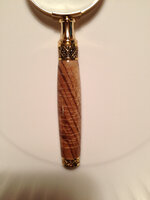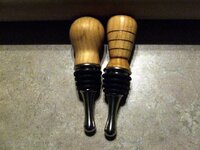Hey guys, I am certainly no expert here, but I have worked with wood and wood finished on gunstocks for many years now. I have only turned four pens to this date. From what I have seen over the years, any hard film coating can and will crack or fade over time. I used an oil finish for this reason.
I have always like an oil finish, I have used a product called Arrow's wood finish for many years on gunstocks because it fills the pores of the wood quickly by being sanded into the wood and it dries overnight to a waterproof finish. You can always give it a few more coats and the sanding job will determine the shine it gives.
I have tried the CA finish and just don't like it. I had to take the pen apart and sand it off because it looked cloudy. I do not have experience with the CA to speak of, but what I do have, I dislike. I think I will stick to my bees wax and oil based finishes for now after reading all of the problems with the CA.
Your results are obviously different from mine, but I simply ask this question, if you know it can fail with time, why would you want to use a finish that can give you a bad name? When I was gunsmithing, there is nothing I would've hated worse than for one of my stocks to have to come back because a finish failed. Just curious on this.
Jeff


